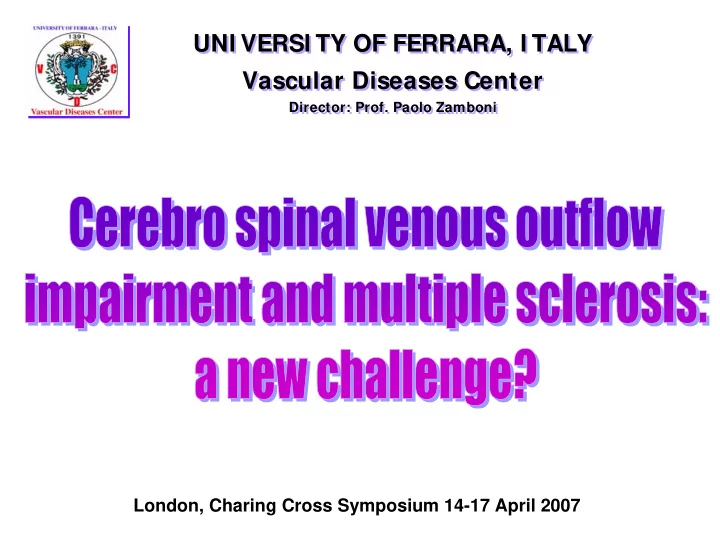

UNI VERSI TY OF FERRARA, I TALY UNI VERSI TY OF FERRARA, I TALY Vascular Diseases Center Vascular Diseases Center Director: Prof. Paolo Zamboni Director: Prof. Paolo Zamboni London, Charing Cross Symposium 14-17 April 2007
BACKGROUND BACKGROUND MS lesion Central vein MR venography of multiple sclerosis. MS lesion Tan IL, van Schijndel RA, Pouwels PJ, van Walderveen Central vein MA, Reichenbach JR, ManoliuRA, Barkhof F. AJNR Am J Neuroradiol. 2000;21:1039-42. MS and the venous system MS and the venous system MS lesion Multiple sclerosis (MS) is an Central vein inflammatory demyelinating disease of the central nervous system characterized by focal venocentric lesions. In MS, MRI venography and dissection demonstrate a central vein oriented on the long axis of the inflammatory lesion, almost constantly a DMCVs
BACKGROUND: BACKGROUND: Multiple sclerosis CVD HI STOLOGY HI STOLOGY • perivenous iron stores • Fibrin Cuffs • Iron-laden macrophage
INFLAMMATION IN VENOUS DISEASE CVD MS Key elements + ? ♣ altered venous haemodynamics ♣ microcirculation overload + + ♣ red blood cells and macromolecules + + extravasation ♣ increased iron deposits + + ♣ macrophages recruitment and + + infiltration ♣ iron-laden macrophages + + ♣ up-regulation of MMPs and down + + regulation of TI MPs ♣ association with HFE mutation + + ♣ Fibrin cuffs + + ♣ Perivenous iron deposits P. Zamboni, Journal of the Royal Society of Medicine 2006 P. Zamboni, Journal of the Royal Society of Medicine 2006
AI MS: to investigate cerebral venous return in MS AI MS: to investigate cerebral venous return in MS PATI ENTS POPULATI ON PATI ENTS POPULATI ON Group A: Group B: MS patients Controls (n=60) (n=60) 40.5 ± 1.3 37.8 ± 1.9 Age (±SD) Sex, M/F 21M/39F 24M/36F Clinical class - 39RR/21SP RR/SP 2.9 ± 0.4 - EDSS Disease 7.7 ± 1 - Duration (years)
Transcranial coded color Doppler of the venous Transcranial coded color Doppler of the venous system (TCSS) system (TCSS)
……. ……. QuickTime™ and a III ventricle YUV420 codec decompressor are needed to see this picture. Internal cerebral vein
QuickTime™ and a YUV420 codec decompressor are needed to see this picture.
DMCVs ICV ICV GV GV Inspiration normal emptying - Expiration reflux FLOW MONODIRECTIONAL BIDIRECTIONAL REFLUX → Veins ↓ Controls MS Controls MS Controls MS TSs 48/60 12/60 8/60 11/60 4/60 37/60 80% 20% 13% 18% 7% 62% dMCVs 58/58 26/60 0/58 7/60 0/58 27/60 100% 43% 0% 12% 0% 45% P<0.0001
Venous reflux promotes expression of adhesion Venous reflux promotes expression of adhesion molecules on the venous wall, and white cells molecules on the venous wall, and white cells migration migration New Engl J Medicine 2006 New Engl J Medicine 2006 MS lesions are constantly venocentric and localized in MS lesions are constantly venocentric and localized in the area of the DMCVs the area of the DMCVs Curr Opin Neurol 2006 Curr Opin Neurol 2006
I s reflux a consequence of MS inflammation in turn affecting the cerebral veins? 2ND PART OF THE STUDY: investigation of extra- cranial veins George Morris “The big dilemma ”
IN PHYSIOLOGY The IJV is the predominant venous outflow pathway in supine position, confirmed by an increased cross-sectional area (CSA), related to increased blood volume in that body position; redirection of venous flow to the vertebral veins (VVs) occurs in upright-position, with compliant reduction of the CSA of the IJV
CONTROLS MS CONTROLS MS I JV CROSS SECTI ONAL AREA I N SI TTI NG AND SUPI NE POSTURE I JV CROSS SECTI ONAL AREA I N SI TTI NG AND SUPI NE POSTURE RR SP RR SP
The difference between cross sectional area measured The difference between cross sectional area measured in supine and in sitting posture ( Δ CSA) was inversely in supine and in sitting posture ( Δ CSA) was inversely correlated to the EDSS disability score (r 2 = - 0.6153; correlated to the EDSS disability score (r 2 = - 0.6153; p< 0.0001) p< 0.0001)
REFLUX RATE I N REFLUX RATE I N THE I JV, VV WAS THE I JV, VV WAS SI GNI FI CANTLY SI GNI FI CANTLY HI GHER I N MS HI GHER I N MS (P< 0.0001). (P< 0.0001). I N MS PATI ENTS I N MS PATI ENTS REFLUX I N BOTH REFLUX I N BOTH POSTURES WAS POSTURES WAS DETECTED I N DETECTED I N 25% OF R-I JV, 25% OF R-I JV, 43% L-I JV, AND 43% L-I JV, AND I N 70% VV, I N 70% VV, VERSUS 0% I N VERSUS 0% I N CONTROLS CONTROLS
SUMMARY AND CONCLUSIONS � The postural mechanism regulating IJV out-flow is The postural mechanism regulating IJV out-flow is compromised in MS compromised in MS � Δ CSA is correlated with the disability score CSA is correlated with the disability score � Increased reflux rate in the extracranial veins Increased reflux rate in the extracranial veins � Transmission of reflux in the DMCV, anatomically related to MS Transmission of reflux in the DMCV, anatomically related to MS plaques plaques
Recommend
More recommend